Lower Back Pain – Symptoms, Treatment and Exercises – Part II
- February 27, 2023

This is the second part of our two part series on lower back pain, its causes, treatments and exercises. In the first part we discussed the structure of the back and some common causes of lower back pain.
In this part we go on to discuss treatment and exercises you can do to relieve your lower back pain.
Treatment for Lower Back Pain
Physiotherapy is an ideal choice for the treatment of lower back pain.
Your experienced physiotherapy will firstly diagnose the cause of your lower back pain and then combine manual therapy, which is hands-on treatment including techniques like myofascial release, mobilisation and dry needling, along with specific exercises (similar to the exercise plan at the end of this article).
Our physiotherapy philosophy is to provide sufficient treatment, advice and exercise prescription to enable each patient to regain control over their injury or pain to enable them to continue self-treatment with confidence and regaining of normal function and activities.
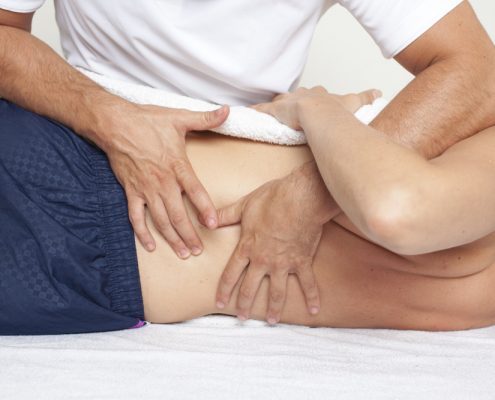
Self-treatment for Lower Back Pain
- Staying active is the key to reducing postural lower back pain. 30 minutes a day of gentle exercises like walking, swimming or cross-trainer are ideal. Joining an exercise class is a great way to keep fit and healthy and reduce postural back pain. Even 2 x 15 minutes of daily exercise can be really effective.
- If you sit for long periods, stand up and move around every 20 minutes or so. Introducing simple pelvic and lower back movements will really help.
- If you work daily in an office, establishing a suitable desk and chair position is essential to avoid lower back pain. If you are not sure what position is right for you, arrange for one of our Occupational Physiotherapists to help you.
- If you are not a gym goer, a daily routine of home movement exercises for your lower back (see exercises below) and stretching any tight leg muscles like quadriceps, hamstring and glutes will really help reduce your lower back pain.
- Appling regular heat to the lower back muscles will help to relax the tight and irritated muscles. A shower or massage works best but a hot water bottle is also fine, however, try to still move around and not lie still. Avoid cold as this tightens muscles.
- Over the counter medicines like ibuprofen may help reduce your pain sufficiently to allow to stay active.
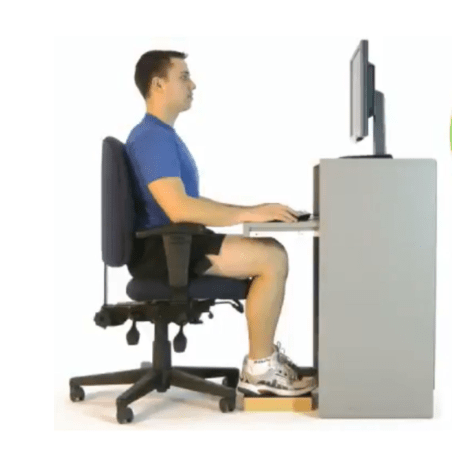
Other Points for Managing Lower Back Pain
- Try not to wait until your lower back pain or discomfort gets really bad. Get into a regular routine following the self-treatment advice along with the exercises below.
- If you are prone to lower back pain, and your workload is about to increase, start the following routine as soon as you can.
- If you are already experiencing postural back pain, start the routine and exercises below. It will take time to make a difference, but you CAN get rid of postural lower back pain.
- If you have had lower back pain for more than 4 weeks or experience regular episodes of lower back pain then arrange to see one of our experienced Physiotherapist.
- Our Occupational Physiotherapy team are experienced in assessing both workplace and workstation environments to ensure correct ergonomic posture and technique is maintained at work, regardless of if you are lifting all day or sit at a desk. For more information follow this link Occupational Health.
Back Pain Exercises
The following exercises will help to mobilise your back, strengthen your core and reduce pain caused by poor posture. Apart from the two core strengthening exercises, all other exercises require slow, relaxed movement rather than stretching. Breathing should also be calm and smooth throughout the exercise.
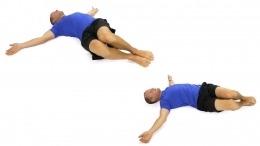
Log Rolling
This is a great warm-up exercise and a good way to mobilise and loosen your lower back. Start by lying on your back with your feet on the ground and knees bent and together. Slowly move your knees side to side going as far as you can without causing pain. Continue for 1 minute.
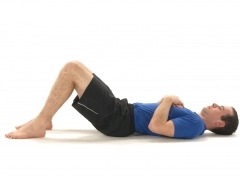
Pelvic Tilt
Lie on your back with your knees bent.
Activate your core muscles by bringing your belly button inward and activating your pelvic floor muscles.
Maintain relaxed abdominal breathing while tilting your pelvis down and flattening your back to the floor. Slowly return to the start position and repeat 6-8 times.
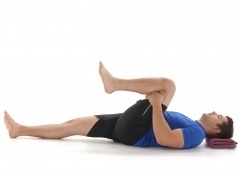
Single Knee to Chest
This is a great stretch for the hip, pelvis and lower back.
Lie on your back and bring one knee up to your chest. Hold for 1-2 seconds and then slowly return to the starting position.
Maintain relaxed breathing throughout the exercise.
Repeat the above steps 4-6 times to each leg.

Cat / Cow
Start on all fours with the hands under your shoulders and knees under your hips, with a neutral (flat) spine.
Slowly round your back as shown in the diagram during relaxed breathing.
Then slowly return to the start position.
Repeat 4-6 times whilst keeping your breathing relaxed.
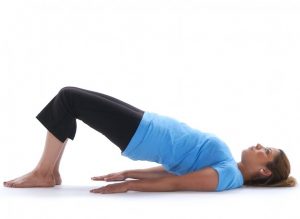
Shoulder Bridge
This is one of the key core strengthening exercises that will help to maintain your back and spine in the correct position.
Lying on your back with your knees bent, as pictured
– Flatten your back by squeezing your tummy muscles
– Squeeze your glute/buttocks
– Slowly lift up off the ground (do not arch your back)
– Hold for 2-3 seconds
– Slowly lower back down and repeat 4-6 times.

Forearm Plank
This is another key core exercise to help strengthen your core muscles and help maintain a strong spine.
Place the elbows directly under the shoulders keeping a neutral back and head aligned with the spine.
Draw in your lower stomach to engage your core muscles. Hold the position for 5-10 seconds, then lower to the ground. Repeat 4-6 times.
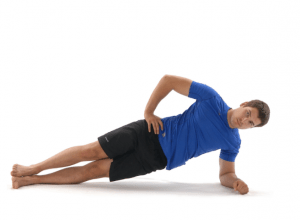
Side Plank
The final core exercise and the most challenging.
Lie on your side with your legs straight and in line with your body. Keep the side of your hip vertical and avoid any rotation.
With your upper body supported on your elbow, make sure your elbow is directly under the shoulder.
Lift your pelvis and hold your body in a straight line. Hold for 5 seconds and slowly lower. Repeat 2-3 times on either side.
The Lunge Exercise for Runners
This is probably the most important exercise for runners.
The primary purpose of the lunge exercise is to engage and strengthen all the key muscles and joints involved with running, especially the glutes. As well as dynamically stretch important running muscles like the hip flexors. The lunge will also improve single leg balance which is another important facet of developing a perfect running technique.
The lunge is an excellent exercise to incorporate into your warm-up routine as it will engage and prepare all the muscle groups used in running. During the off-season, it is a great strengthening exercise to add to your program.
When performed correctly, the lunge will also help maintain a strong upright posture as well as strengthen your core and lower back muscles. If you have space it is best to carry out the exercise as a slow controlled walk.
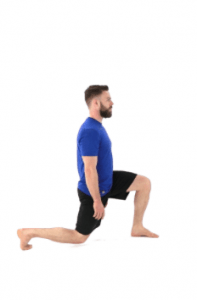
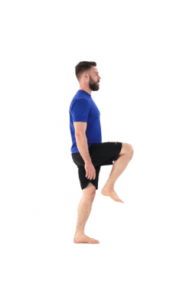
Further Advice for Lower Back Pain
If you require further advice and treatment for back pain, make an appointment with one of our experienced Physiotherapists or call us on 0131 218 3000 or email info@physioclinics.scot

Phil has over 17 years of experience working with professional and international athletes and teams throughout UK, Australia and South Africa, including the South African Springboks, Leicester Tigers and Ulster Rugby as well as the South African Triathlon Team.
Phil Mack